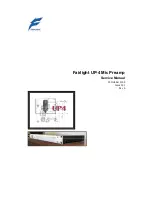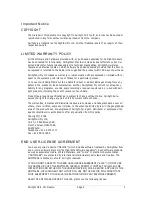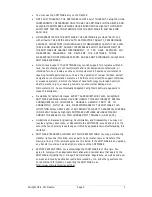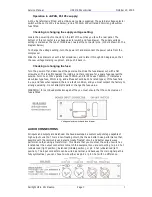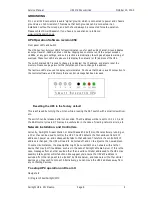
Service Manual
UP4
M
IC
P
REAMPLIFIER
October 23, 2009
Fairlight UP-4 Mic Preamp
Page 6
6
Gain adjustment is achieved with only 5 relays, while offsets are nulled to typically
25microvolts by DC-servo circuits in all stages, resulting in the need for only one
Polycarbonate capacitor in the audio path. No electrolytics are used.
Headroom at all points of the circuit is maintained to the power rails, at +28dBu, and at all
gain settings. Many other designs suffer from degraded input headroom as a result of using a
'long tailed pair' configuration; while the output performance is variously compromised from
op-amp-only; pseudo-balanced; or transformer circuits falling prey to real-world situations
not fully defined or tested in the lab. For example the 'pseudo-balanced' opamp circuit
favored by 80% of manufacturers induces around 9dB of noise as a result of the positive
feedback employed. As this is a dynamic problem, it measures well without signal present,
and only manifests when excited by low level signals, resulting in worse noise performance in
use. Driving outputs from op-amps directly brings other drawbacks such as far higher
distortion under load and long cables, instability, and degraded slew rate performance. Again,
often problems that manifest in 'system' use, and so slip through the design stage, and don't
show up on a specification sheet.
To optimize these output drive issues we have developed a discrete transistor output circuit,
capable of driving into long cables and difficult loads, and switch-select between balanced or
unbalanced configuration. (This circuit is also in use in the C2 and other products).
Discrete FET's are used for break-before-make switching of phase reverse and muting
functions; and with balanced, proprietary drive circuitry, outperform the charge introduction,
off isolation, and rdson performance of the commonly used SSM2402 family of i.c. switches.
OP275 amplifiers are used for the audio signal path. These were chosen in listening tests for
their sound and hybrid FET/Transistor inputs, together with their overall performance.
Large-geometry transistors bypass the first stage input transistors to provide an EIN figure of
133dB (see specifications). NPN or PNP input transistors can be fitted, so that should any
advantageous new devices become available we have the best chance for their inclusion.
As a result of both remote control and the surface mounting of components, a compact
physical layout has been possible. Cables to and from front panel controls become
unnecessary, and pcb layout problems are reduced such as crosstalk, noise pickup and
stability. This was an advantage in producing the 01/7 SSL Channel card, reducing wiring and
installation.
UP4 INSTALLATION NOTES
POWER SUPPLY
The unit is rated at 50 watts, and can be set to work from 90-250v supplies, at 50 or 60Hz.
Operation in USA or CANADA, 110-120v supply:
A north American 'NEMA' type 3-pin power cable is supplied; the external voltage selector
switch will be set to 115v (see below); and a T500mA; 250volt rated 20mm long slow-blow
fuse fitted.
Operation in the UK, AUSTRALIA or EUROPE, 220-250v supply:
A power cable with the proper attachment plug for the country will be required; the external
voltage selector switch will be set to 230v (see below); and a T250mA; 250volt rated 20mm
long slow-blow fuse fitted.

